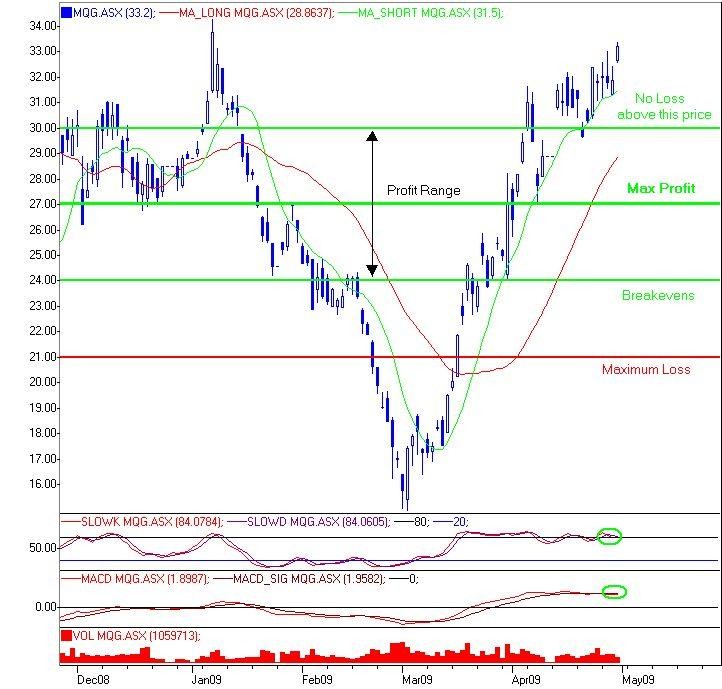Options Strategies
Post on: 9 Август, 2015 No Comment

From Wikipedia, the free encyclopedia
In finance an option strategy is the purchase and/or sale of one or various option positions and possibly an underlying position.
Options strategies can favor movements in the underlying that are bullish, bearish or neutral. In the case of neutral strategies, they can be further classified into those that are bullish on volatility and those that are bearish on volatility. The option positions used can be long and/or short positions in calls and/or puts at various strikes.
* 1 Bullish strategies
* 2 Bearish strategies
* 3 Neutral or non-directional strategies
o 3.1 Bullish on volatility
o 3.2 Bearish on volatility
* 4 See also
* 5 References
* 6 External links
Bullish strategies
Bullish options strategies are employed when the options trader expects the underlying stock price to move upwards. It is necessary to assess how high the stock price can go and the time frame in which the rally will occur in order to select the optimum trading strategy.
The most bullish of options trading strategies is the simple call buying strategy used by most novice options traders.
Stocks seldom go up by leaps and bounds. Moderately bullish options traders usually set a target price for the bull run and utilize bull spreads to reduce cost. (It does not reduce risk because the options can still expire worthless.) While maximum profit is capped for these strategies, they usually cost less to employ for a given nominal amount of exposure. The bull call spread and the bull put spread are common examples of moderately bullish strategies.
Mildly bullish trading strategies are options strategies that make money as long as the underlying stock price does not go down by the options expiration date. These strategies may provide a small downside protection as well. Writing out-of-the-money covered calls is a good example of such a strategy.
Bearish strategies
Bearish options strategies are the mirror image of bullish strategies. They are employed when the options trader expects the underlying stock price to move downwards. It is necessary to assess how low the stock price can go and the time frame in which the decline will happen in order to select the optimum trading strategy.
The most bearish of options trading strategies is the simple put buying strategy utilized by most novice options traders.
Stock prices only occasionally make steep downward moves. Moderately bearish options traders usually set a target price for the expected decline and utilize bear spreads to reduce cost. While maximum profit is capped for these strategies, they usually cost less to employ. The bear call spread and the bear put spread are common examples of moderately bearish strategies.
Mildly bearish trading strategies are options strategies that make money as long as the underlying stock price does not go up by the options expiration date. These strategies may provide a small upside protection as well. In general, bearish strategies yield less profit with less risk of loss.
Neutral or non-directional strategies
Neutral strategies in options trading are employed when the options trader does not know whether the underlying stock price will rise or fall. Also known as non-directional strategies, they are so named because the potential to profit does not depend on whether the underlying stock price will go upwards or downwards. Rather, the correct neutral strategy to employ depends on the expected volatility of the underlying stock price.
Examples of neutral strategies are:
* Guts sell in the money put and call
* Butterfly buy in the money and out of the money call, sell two at the money calls, or vice versa
* Straddle holding a position in both a call and put with the same strike price and expiration. If the options have been bought, the holder has a long straddle. If the options were sold, the holder has a short straddle. The long straddle is profitable if the underlying stock changes value in a significant way, either higher or lower. The short straddle is profitable when there is no such significant move.
* Strangle the simultaneous buying or selling of out-of-the-money put and an out-of-the-money call, with the same expirations. Similar to the straddle, but with different strike prices.
* Risk Reversal
Bullish on volatility
Neutral trading strategies that are bullish on volatility profit when the underlying stock price experiences big moves upwards or downwards. They include the long straddle, long strangle, short condor and short butterfly.
Bearish on volatility
Neutral trading strategies that are bearish on volatility profit when the underlying stock price experiences little or no movement. Such strategies include the short straddle, short strangle, ratio spreads, long condor and long butterfly.
See also
* Options spread
* Synthetic options position
* Options arbitrage
References
* McMillan, Lawrence G. (2002). Options as a Strategic Investment (4th ed. ed.). Prentice Hall. ISBN 0-7352-0197-8.
External links
* Chicago Board Options Exchange
* Powerful Option Trading Strategies for Consistent Income
Swaps
Basis swap · Constant maturity swap · Credit default swap · Currency swap · Equity swap · Forex swap · Inflation swap · Interest rate swap · Total return swap · Variance swap · Volatility swap · Correlation swap · Conditional variance swap
Forwards and Futures
Backwardation · Commodity futures · Contango · Currency future · Financial future · Forward market · Forward price · Forward rate · Interest rate future · Margin · Pricing of Forwards · Pricing of Futures · Single-stock futures · Slippage
Other derivatives
Credit default option · CLN · Contract for difference · CPPI · Credit derivative · ELN · Equity derivative · Foreign exchange derivative · Fund derivative · Inflation derivatives · Interest rate derivative · PRDC · Real estate derivatives · Real options
Market issues
Tax policy · Consumer debt · Corporate debt · Government debt · Late 2000s recession














